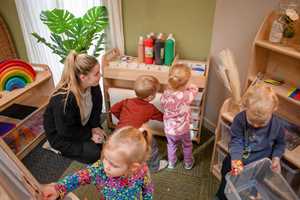
Lesson Ideas and Activities
Your school grounds can offer the most wonderful opportunities for children to discover and learn all about mathematics
In a safe and familiar environment with ready access to your teaching resources and school playground equipment, school grounds are the perfect place to delve into the world of shapes and angles, numbers and patterns, dimensions and surveys and so much more.
Developing mathematical thinking and learning mathematical skills can be part of an Early Years learner’s outdoor play experience every day.
All through the Key Stages, with the extra space that school grounds provide, you can bring to life a maths lesson in a three dimensional form and allow your children to be actively involved and creative with it.
With scale comes freedom and vigour and children will be more captivated and inspired, which in turn can only improve their understanding of maths and help them to establish a real link between what they are learning, and how it is relevant to their lives and the world they live in.
Here we have some great ideas to help you maximise your school grounds and make the most of your school playground equipment for outdoor mathematics lessons:

Water + Sand = Fun!
Water and Sand based play are real favourites among children and they make fantastic resources for maths lessons. You can cover so many topics with them such as measurement, quantities, weights, patterns, speed, velocity, timing, and concepts such as floating, sinking and movement.
Sand Boxes and Mud Kitchens filled with sand or mud are not just for digging and getting messy in (although they are great for that too!).
Making sand or mud pies at your Mud Kitchen opens up multiple opportunities to learn about weights and quantities, portions and divisions, multiplication, addition and subtraction.
Measure out “ingredients” to make your mud pies, and ask children to think about the weights and quantities of each ingredient that they need. How many children are in the class? Count out how many mud pies they will need to make so that everybody has one. What if two children go home for lunch? How many mud pies will you need then?
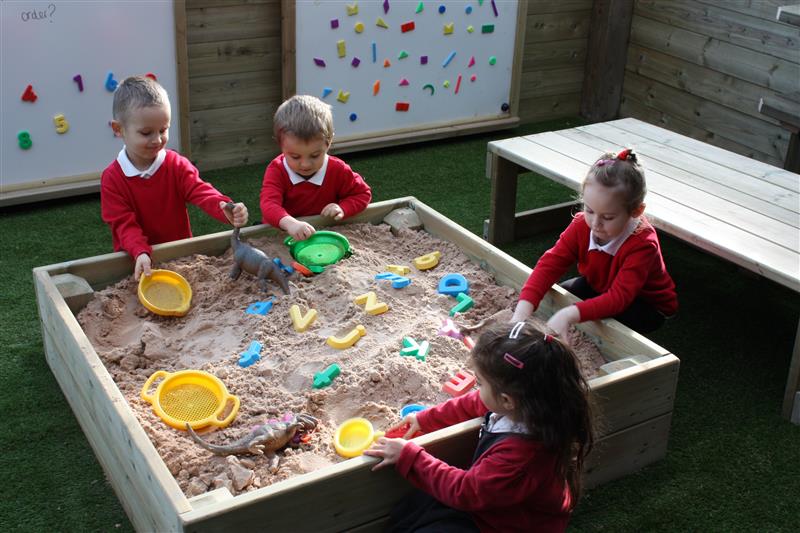
Be creative and they can practice counting and arithmetic without even noticing they are doing it!
Children can write their calculations down on the Mud Kitchen’s chalkboard to practice using different mathematical symbols.
Children can enjoy filling containers of different shapes and sizes with sand to build three dimensional statues.
Add water to the sand to give it some hold and give children various utensils to press into the sand to create shapes and patterns. Discuss what you see. Can anyone make a sand cone? Are any shapes particularly difficult to make with sand and why?
Put a wooden plank across your Sand Box and ask children to balance on it to view their constructions from different angles and perspectives.
What about making repeat patterns in the sand? There are no limits to this once they get going! Mathematical conversation can easily flow whilst the children are engaged in these activities.
Talk to them about why some of the containers will fit inside each other and why some won’t. Which is the smallest and which is the largest?
Notice how sand slides down the side of a receptacle to form a specific shape. Pour sand through different receptacles and discuss whether the size of the holes makes a difference to how quickly the sand runs through them.
Even just making footprints together and counting and comparing their sizes has a mathematical angle!
We love water play too, and now that we are coming into the summer months what could be better than splashing around outside with your friends!
Water Tables are great mathematical resources and can be used in a similar way to Sand Boxes.
With water you can also look at displacement by sinking objects into it, and discuss what elements and object needs to have to float.
Water travel is fascinating for children, whether floating toys across it or watching it flow freely at different speeds.
A Water Wall makes an outstanding investigative resource for learning mathematics during Early Years and at Key Stages 1 and 2.
Children can pump water through it, fill up the reservoir at the top, then predict and watch what happens as the reservoir fills up, volume increases and the water starts to flow down the channels.
Balance, equilibrium, quantity, mass and weight are all part of it. Ask children to look at the water wheel. What shape it is and what happens to it when the water hits it? What factors influence the speed at which it rotates?
What happens to the water flow if you change the positioning and angles of the water channels?
View some fantatsic messy play equipment here
.jpg)
Know Your Natural Numbers!
The wonderful thing about Natural Playground Equipment, is the fact it's truly cross curricular, and a vital resource for linking other subject such as science and the environment to mathematics.
The other wonderful thing is that it is extremely engaging, for example, most Early Years learners love a good lesson involving mini beasts!
Whether it’s a Planter, a Bug Hotel or a full scale Wildlife Area, children can feed their curiosity and be actively involved with investigative mathematical learning.
Let’s look at life cycles and wildlife surveys. Step outside to your Wildlife Area and see what living creatures and plants you can find.
Discuss how different species stay alive for different amounts of time.
Produce a survey to find out what different types of creatures live in the wildlife area, how many there are and what are there more or less of. Make up a tally chart to record how many worms, ants or bees appear each day.
Simple flowers, ants, worms, beetles and caterpillars are perfect for studying lifecycles so pick one to study as a group.
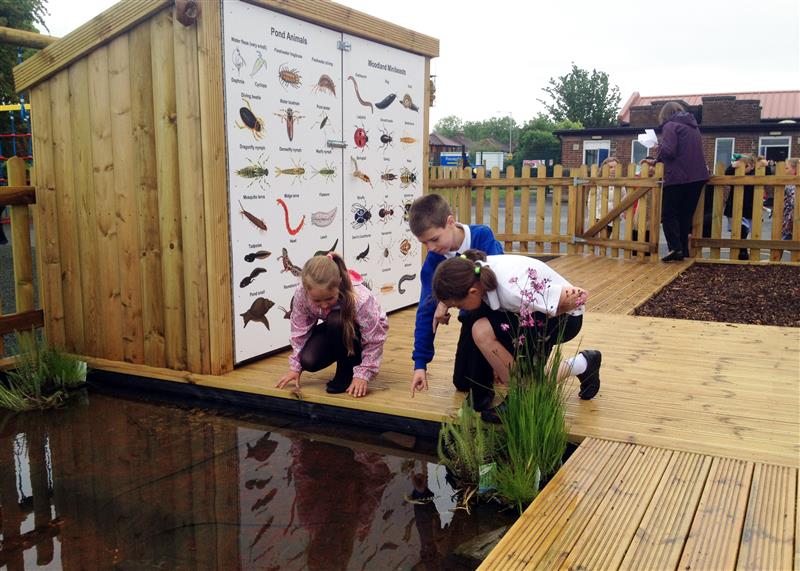
Children can do some investigations of their own online or at the library first. How long does their creature live for? How does it begin, and what stages does it grow through during its lifespan?
Create a timeline in the wildlife area with twigs or sticks to map out these stages. What does the creature need to survive and in what quantities? Keep a photo diary so that the children can see the daily changes and discuss them later.
Be sure to look at items that you can find plenty of at certain times of the year such as acorns, pebbles and twigs, and let children gather them together as part of their survey so they have numerous opportunities to practice counting.
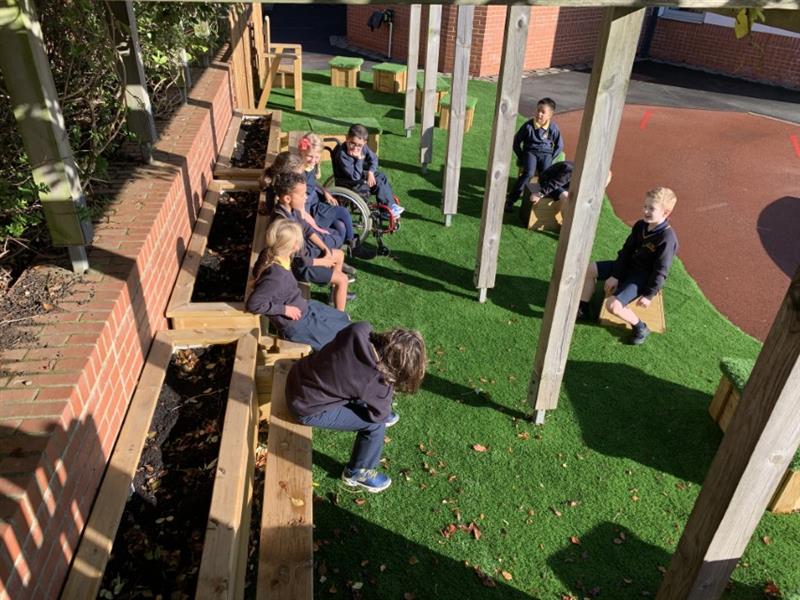
Use these activities to help demonstrate the use of language, such as ‘same’, ‘fewer’, ‘more’ and ’less’.
Why not have an insect race or look at how quickly snails can move? Line them up at the edge of the wildlife area and see how much distance the snails can cover in 2 minutes!
The children should be able to decide how best to measure the distances covered, and you can encourage them to practice counting the seconds down.
Discuss which is the fastest, slowest, largest or smallest snail and see if size has an influence on speed.
.jpg)
Children will enjoy getting involved with gardening and filling your Planters with different species and colours of plants.
They should decide how many plants will be needed to fill the space, how much compost is needed and how deep it needs to be. How deep do the seeds, bulbs or plants need to go? Ask them to draw up a rota for watering, weeding and pruning the plants themselves.
They should make this up as a chart so they can plot out who is responsible when and who’s turn is next. Agree and measure out how much water they need and how frequently they should be watered.
Include this information on the chart. Once the plants start to grow children can measure them with tape measures, or even with their own bodies.
This is great fun if they manage to produce a beanstalk or a tall sunflower!

A Dig Pit can be used in a similar way and you can fill it with all sorts of things beside soil, whether that be sawdust, gravel, bark or leaves.
This will help children to develop their understanding of capacity and they can investigate with a variety of digging implements.
Turn a digging session into a problem solving session by asking them to see if they can bury a number of items so that they are completely covered, or to see how many stones they can fit into a hole dug with a spoon.
Don’t be afraid of using whatever you can find outdoors in your school grounds.
Twigs, stones, leaves, flowers, gravel, and items with seasonal interest such as pine cones, shells, conkers and acorns add variety and interest.
Provide some different sized containers and trays so the children can have a go at sorting them into separate items ranked according to shape or size.
Discuss different ways that they could sort the same items, and use weighing scales and tape measures as well. Let the children see the value in what they are doing by displaying their work or taking pictures to look at together later.
Click here to see our range of natural play equipment
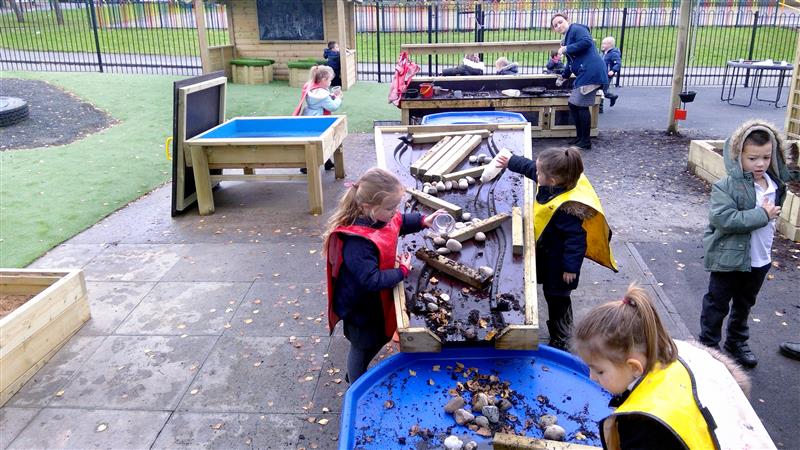
Mathematics Through Movement
Young children learn a lot about maths through their senses and through movement. Playing mathematical games and using their bodies to learn gives them opportunities to repeat the same activities and movements, and to build up and reinforce their understanding of the subject.
It makes sense, then, to capitalise on a child’s love of games with some outdoor activities designed to support mathematical learning.
It is worth having some really good Playground Markings not just to add interest and a different dimension to playtimes, but because used in the right way, they can be brilliant for outdoor maths lessons.
Encouraging children to jump across a hopscotch calling out the numbers as they go may be a very traditional playground game, but the concept has lasted for a reason!
Things have moved on though and there are some fantastic, innovative playground markings available to encourage counting, addition and subtraction in different ways.
Brightly coloured and numbered animal, clown or bullseye targets are perfect for this, and with a few bean bags to throw at the targets they can make up their own games!
Eight or sixteen point compasses encourage children to navigate their way around a playground while building on their understanding of position and direction.
A giant snakes and ladders is a great fun way to practice counting as children use their bodies to jump along the squares! With different shapes and angles there is plenty to talk about with children as far as maths is concerned.
How many different patterns and shapes can they find and what are the special features of these shapes?
It is amazing how much fun children can have on well-designed playground flooring which really does inspire learning!
You can see our huge range of fun and engaging Playground Markings here
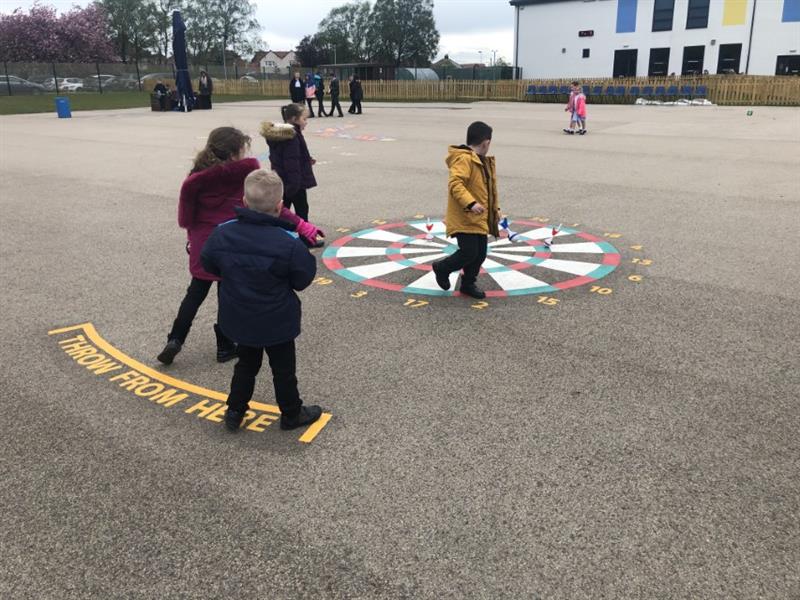
Active Play Equipment such as Trim Trails and Play Towers can be incorporated into outdoor maths lessons too.
Children love speeding down slides, but just how fast can they go? Can their friends time them and measure their speed and distance covered?
Discuss gravity as children take different items up to the top of a frame and let them fall to the floor. Which items fall more quickly and what factors influence this.
Children can take part in larger scale measurements using metre lengths of rope around the equipment, or even their own bodies!
Remember that rope can measure curves as well as straight lines, so set challenges for children to find objects with a length or girth of 1 metre or more!
Use chalk to mark measurements and teach them how to round up or down.
Product Spotlight
Outdoor Activity Panels are another way of bringing a maths lesson outside. Setting up a reflection area with Giant Mirrors and Wobbly Mirrors allows children to notice how things look through mirrors, and how different perspectives, or items viewed at different angles, can change a view.
How does light reflect? What do they see differently in a distorting mirror and how does their size and shape change? Make the most of Mark Making Panels to encourage children to draw out their observations, record their findings and learn to use symbols.
They are a wonderful no-pressure resource which allow children to feel free to experiment with what they are learning and to build up their confidence in maths.
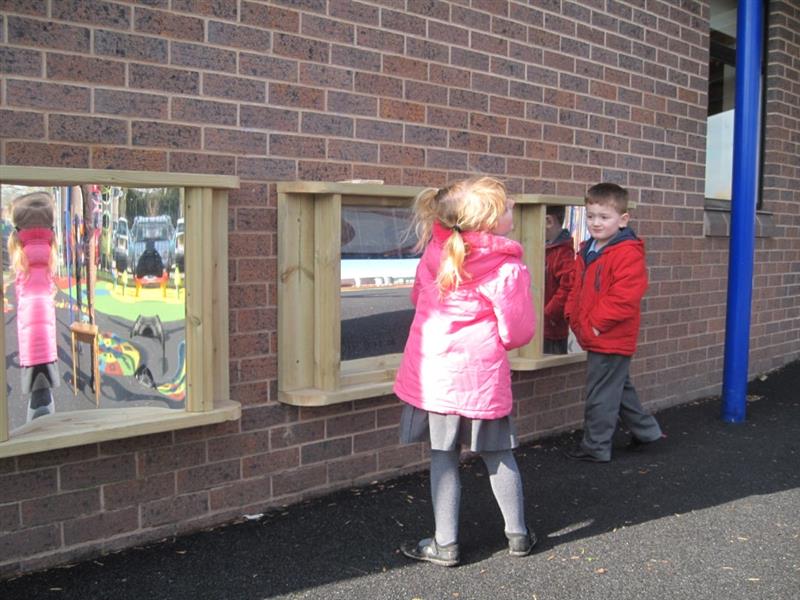
Remember throughout all of these fun activities to keep talking to your children using mathematical language, and they are guaranteed to absorb it. Encourage them to solve problems themselves, support their ideas and prompt them with open ended questions.
Give them plenty of opportunity to express their own ideas, reflect on what they have found and work out their own explanations, and they will achieve so much.
If you are looking to maximise your school grounds for outdoor maths lessons and are considering some new school playground equipment to help you do this, please Contact Us to see how we can help you.






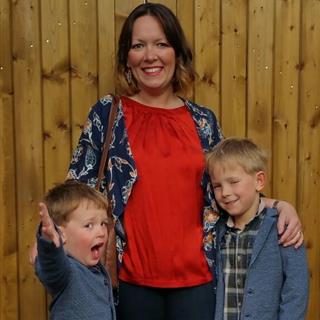
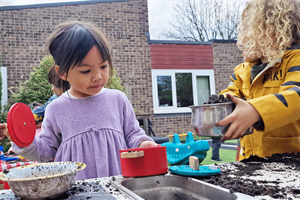
 (Custom).jpg)